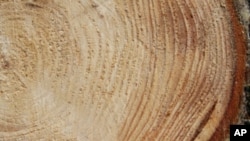For hundreds of years the Khmer empire ruled in what is now Cambodia.
But in the 13th century, the capital city, Angkor, died off, and a new scientific study indicates that climate, specifically decades of drought interspersed with intense monsoons, helped bring down the Khmer capital.
In the ancient world, Angkor was known for its sophisticated water system.
"Angkor was really the dominant civilization in that part of the world without any question," said Brendan Buckley, the Columbia University scientist who led the study.
"It was the center of their universe. And it was called the 'hydraulic city' because it had really remarkably massive arrays of barays, which are these giant water tanks and a series of canals and interconnected waterways that was really unparalleled in the ancient world in that part of the world."
Buckley isn't an archaeologist. He studies tree rings, which record the growth history of trees that can be hundreds of years old, or even older. A new ring is added every year, and thicker rings represent a kind of savings account, when the tree collects more nutrients than it can use. Thin rings show the tree is barely getting along, like during a drought year.
Using samples from around Southeast Asia, Buckley and his colleagues saw this pattern in tree rings from recent years, when he could corroborate the rings with other historical climate information. His newest tree ring samples, from the rare Fokienia hodginsii cypress in southern Vietnam, enabled him to take the climate record back much further.
"We realized we have trees that are more than 1,000 years old. And we started seeing these big, giant periods of drought that took place around that time. And as I started to get more interested in the history of Southeast Asia, I realized that that was the time of the collapse of Angkor."
The research team used what are called core samples from hundreds of trees throughout Southeast Asia. Using a hollow tube, they drill into the tree and extract a 5-mm wide cylinder that shows each ring starting with the most recent, just under the bark.
By comparing rings from different trees and with other historical data, you can often identify particular rings with the exact calendar year that they grew.
"We were able to match up the narrow and wide rings exactly so that we can assign the exact calendar dates to the exact rings of every tree," Buckley explained. "In the tropics, a lot of tree species don't even form rings that we can see. So to be able to get a tree that, first of all, has very clear rings that we're able to visually match to each other and then go through and produce these long records was remarkable."






